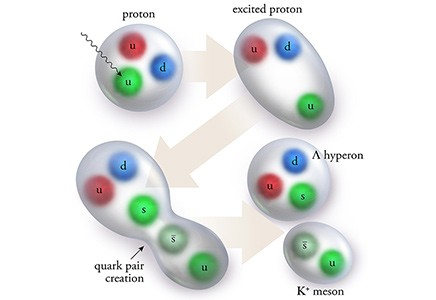Up and Down Quarks Favored Over Strange Ones

Researchers added extra energy to the proton to produce a pair of quarks, which then yielded new particles. In this illustration, a strange/anti-strange quark pair (s and s) yields a Lambda (^) hyperon and Kaon (K+ meson). The researchers found that strange/anti-strange quark pairs were produced about one-third as often as pairs of up/anti-up (u) and down/anti-down (d) quarks.
Additional Links
The proton's primary building blocks, up and down quarks, are produced more often than strange quarks in scattering experiments.
The Science
Protons are composed of three quarks – two up quarks and one down quark – that are bound together by the “strong force” – one of the four natural forces in our universe. Due to a quirk of the strong force, an accelerator can produce new particle pairs from the proton by imparting extra energy to the particles, with a beam of electrons. Researchers found that when enough energy is provided for a single pair of up, down, or strange quarks, the new particles are far more likely to be made of the proton’s primary quarks (up/anti-up or down/anti-down) than of strange quarks, the next most-prolific quark found in nature.
The Impact
A suppression of strange quark production relative to up and down quark production by a factor of three had previously been noted in experiments at very high energies, such as at the Large Hadron Collider at CERN. This is the first time that the result has been verified when a single pair is produced, providing evidence for the universal nature of the quark pair creation process.
Summary
One of the biggest mysteries of the structure of ordinary matter revolves around the force that binds the smallest particles of matter together. The strong force is one of the four fundamental forces, along with gravity, the weak force, and electromagnetism. The strong force binds together the quarks that build the protons and neutrons inside the nucleus of every atom in the visible universe. The strong force is so strong, in fact, that it will never allow a quark to be found alone: All quarks are bound up with other quarks inside composite particles, a characteristic called confinement. Researchers studying the dynamics of the strong force typically must do so by observing how the strong force allows multi-quark particles to manifest when produced in particle accelerators. In this experiment, a 5.5-GeV beam of electrons was directed onto a target of liquid hydrogen, which has a single proton in its nucleus. The researchers collected data on interactions that produced a single pair of quarks that then yielded a positively charged particle that was measured in the Continuous Electron Beam Accelerator Facility (CEBAF) Large Acceptance Spectrometer, along with a neutral particle identified by its missing mass; CEBAF is a nuclear physics scientific user facility. These interactions included a proton and a neutral pion (for up/anti-up), a neutron and positive pion (for down/anti-down), and a Lambda and a Kaon (for strange/anti-strange). The researchers found that strange/anti-strange quark pairs were produced about one-third as often as their light-quark counterparts, consistent with results from much higher energy, thus providing insight into confinement.
Contact
Mac Mestayer
Thomas Jefferson National Accelerator Facility
mestayer@jlab.org
Funding
This work was supported by the U.S. Department of Energy's Office of Science, the National Science Foundation, the Italian Istituto Nazionale di Fisica Nucleare, the French American Cultural Exchange (FACE) and Partner University Funds (PUF) programs, the French Centre National de la Recherche Scientifique, the French Commissariat à l’Energie Atomique, the United Kingdom’s Science and Technology Facilities Council, the Chilean Comisión Nacional de Investigación Científica y Tecnológica (CONICYT), and the National Research Foundation of Korea. CEBAF is a DOE Office of Science User Facility.
Publications
M.D. Mestayer, K. Park, et al. (CLAS Collaboration). “Strangeness suppression of qq creation observed in exclusive reactions.” Physical Review Letters 113, 152004 (2014). [DOI: 10.1103/PhysRevLett.113.152004]
Highlight Categories
Program: NP
Performer/Facility: University, DOE Laboratory, SC User Facilities, NP User Facilities, CEBAF
Additional: Collaborations, Non-DOE Interagency Collaboration, International Collaboration
August 2015

